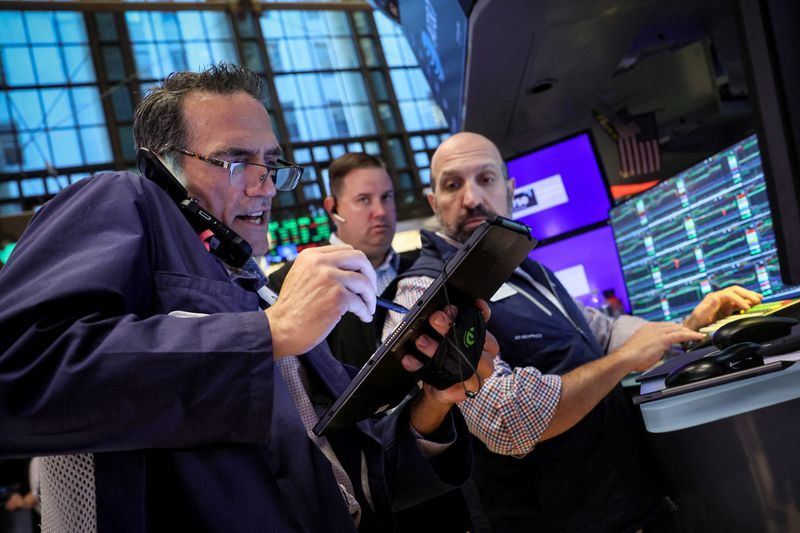By Lewis Krauskopf and Suzanne McGee
(Reuters) – A selloff that rocked fairness markets around the globe is clouding the outlook for traders trying to purchase shares on a budget, as worries over the U.S. financial system and disappointing tech earnings threaten extra losses forward.
A two-day rout late final week left the practically 6% from its July peak whereas the tech-heavy prolonged losses to notch its first 10% correction from a file excessive since early 2022. Equities plunged in Europe and Asia as effectively, with Japan’s index shedding practically 5% for the week.
The market tumble presents a dilemma as one other week of buying and selling is about to unfold. Leaping into shares in periods of weak point has rewarded traders during the last two years, because the S&P 500 has climbed about 50% from its Oct 2022 low.
However patrons of the dip threat being steamrolled if recession fears develop following final week’s run of alarming U.S. information. The S&P 500 has fallen a mean of 29% throughout recessions since World Conflict Two, in response to Truist Advisory Companies.
Saturday’s earnings report from legendary investor Warren Buffett’s Berkshire Hathaway (NYSE:) can also give cut price hunters pause: the conglomerate bought about half its stake in Apple (NASDAQ:) and let its money pile soar to $277 billion within the second quarter. Berkshire typically lets money construct up when it will possibly’t discover entire companies or particular person shares to purchase at honest costs.
“People are starting to reassess what their risks are and whether they are properly positioned.” stated Mark Travis, a portfolio supervisor at Intrepid Capital, noting additionally that elevated valuations are giving traders pause.
Shares have soared this 12 months in a rally fueled by pleasure over synthetic intelligence know-how and a so-called Goldilocks financial system the place progress stayed resilient whereas inflation cooled.
The market’s urge for food for threat took successful this previous week. Considerations that the Federal Reserve could also be hurting financial progress by ready too lengthy to chop rates of interest pushed merchants to dump every thing from richly-valued chipmakers to shares of commercial corporations and head to secure harbors equivalent to U.S. authorities bonds.
Selloffs after disappointing earnings from tech-focused corporations equivalent to Amazon (NASDAQ:), Alphabet (NASDAQ:) and Intel (NASDAQ:), in the meantime, exacerbated considerations that shares might have turn into too richly valued.
BRIGHT SPOTS
However, some traders consider the current tumble is merely a pause in a powerful 12 months for markets, and are in search of the chance to purchase.
“We’ve been looking to potentially get into some of those expensive names and frustrated we haven’t had an opportunity, and now we’re getting there,” said Lamar Villere, portfolio manager at Villere & Co.
The S&P 500 and Nasdaq are both up around 12% year-to-date even with the recent selloff. Chipmaker Nvidia (NASDAQ:), whose blistering climb became emblematic of the AI craze, is sitting on a year-to-date gain of about 117%, despite falling more than 20% from its high.
Economists have pointed to bright spots in Friday’s jobs report, including a second straight month of hefty workforce growth. Some also said that Hurricane Beryl, which slammed the Gulf Coast last month, may have skewed the statistics.
And while expectations for tech companies’ results may have been high, some of the heavyweights delivered strong earnings, including Apple and Facebook-parent Meta Platforms (NASDAQ:).
Big tech stocks “continue to have great businesses, big competitive moats. Their cash flow remains strong,” stated Michael Arone, chief funding strategist at State Street (NYSE:) Global Advisors. “Buyers often overreact within the short-term.”
‘FEAR TRADE’
Others, however, have noted that while stock valuations edged lower in the recent selloff, they remain elevated by historical standards.
The S&P 500 was trading last week at 20.8 times forward 12-month earnings estimates, down from 21.7 reached in mid-July, according to LSEG Datastream. The index’s long-term average is 15.7 times forward earnings. That could leave stocks primed for further selling if more bad news hits.
“This isn’t a Category 3 hurricane, but we are seeing how markets react to signs that the economy is normalizing after turning hot in the first half of this year,” said Art Hogan, chief market strategist at B. Riley Wealth. “Markets can find themselves overreacting and investors glom on to anything as an excuse to take profits.”
A lack of major economic data releases until the consumer price report on August 14 could keep markets on edge. Indeed, worries over economic growth have traders more spooked than they have been in months.
The Cboe Volatility index – known as Wall Street’s fear gauge – hit its highest since March 2023 on Friday as demand for options protection against a stock market selloff surged.

In the meantime, the yield on the benchmark 10-year U.S. Treasury, which strikes inversely to bond costs, sank practically 40 foundation factors this week, the biggest weekly fall since March 2020 as traders priced in price reduce expectations and sought shelter from future volatility.
“That’s a huge move,” stated Michael Farr, president and CEO of Farr, Miller & Washington. “It definitely appears to be like like there is a worry commerce there.




